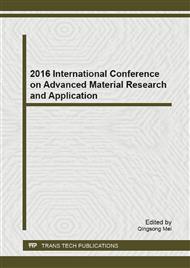[1]
Wu, Y. -F., and Jiang, J. -F. (2013). Effective strain of FRP for confined circular concrete columns., Composite Structures, 95, 479–491.
DOI: 10.1016/j.compstruct.2012.08.021
Google Scholar
[2]
Lim, J.C., and Ozbakkaloglu, T. (2015). Influence of Concrete Age on Stress-Strain Behavior of FRP-Confined Normal- and High-Strength Concrete., Construction and Building Materials, 82, 61-70.
DOI: 10.1016/j.conbuildmat.2015.02.020
Google Scholar
[3]
Vincent, T., and Ozbakkaloglu, T. (2015). Compressive behavior of prestressed high-strength concrete-filled Aramid FRP tube columns: Experimental observations., Journal of Composites for Construction, ASCE, 19(6), 04015003.
DOI: 10.1061/(asce)cc.1943-5614.0000556
Google Scholar
[4]
Vincent, T. and T. Ozbakkaloglu (2015). "Influence of shrinkage on compressive behavior of concrete-filled FRP tubes: An experimental study on interface gap effect, Construction and Building Materials, 75, 144-156.
DOI: 10.1016/j.conbuildmat.2014.10.038
Google Scholar
[5]
Vincent, T. and T. Ozbakkaloglu, Influence of slenderness on stress-strain behavior of concrete-filled FRP tubes: an experimental study, ASCE, J. Compos. Constr. 10. 1061/(ASCE)CC. 1943-5614. 0000489, 04014029 (2015).
DOI: 10.1061/(asce)cc.1943-5614.0000489
Google Scholar
[6]
Ozbakkaloglu, T. (2015). A novel FRP-dual grade concrete-steel composite column system., Thin-Walled Strucutres, 96, 295-306.
DOI: 10.1016/j.tws.2015.08.016
Google Scholar
[7]
Xie, T. and Ozbakkaloglu, T. (2015). Behavior of steel fiber-reinforced high-strength concrete-filled FRP tube columns under axial compression., Engineering Structures, 90, 158-171.
DOI: 10.1016/j.engstruct.2015.02.020
Google Scholar
[8]
Ozbakkaloglu, T., and Xie, T. (2016). Geopolymer Concrete-Filled FRP Tubes: Behavior of Circular and Square Columns under Axial Compression., Composites Part B, 96, 215-230.
DOI: 10.1016/j.compositesb.2016.04.013
Google Scholar
[9]
Ozbakkaloglu, T., Lim, J. C., and Vincent, T. (2013). FRP-confined concrete in circular sections: Review and assessment of stress–strain models., Engineering Structures, 49, 1068–1088.
DOI: 10.1016/j.engstruct.2012.06.010
Google Scholar
[10]
Yu, T., Teng, J. G., Wong, Y. L., and Dong, S. L. (2010). Finite element modeling of confined concrete-I: Drucker-Prager type plasticity model., Engineering Structures, 32(3), 665-679.
DOI: 10.1016/j.engstruct.2009.11.014
Google Scholar
[11]
Youssf, O., ElGawady, M. A., Mills, J. E., and Ma, X. (2014). Finite element modelling and dilation of FRP-confined concrete columns., Engineering Structures, 79, 70–85.
DOI: 10.1016/j.engstruct.2014.07.045
Google Scholar
[12]
Jiang, J. F., and Wu, Y. F. (2012). Identification of material parameters for Drucker-Prager plasticity model for FRP confined circular concrete columns., International Journal of Solids and Structures, 49(3-4), 445-456.
DOI: 10.1016/j.ijsolstr.2011.10.002
Google Scholar
[13]
Lim, J. C., and Ozbakkaloglu, T. (2014).
Google Scholar
[14]
ABAQUS (2012). ABAQUS Analysis User's Manual., version 6. 12, Dassault Systèmes Simulia Corp., Providence, RI, USA.
Google Scholar
[15]
Ozbakkaloglu, T., and Lim, J. C. (2013). Axial compressive behavior of FRP-confined concrete: Experimental test database and a new design-oriented model., Composites Part B, 55, 607-634.
DOI: 10.1016/j.compositesb.2013.07.025
Google Scholar
[16]
Lim, J. C., and Ozbakkaloglu, T. (2014). Confinement model for FRP-confined high-strength concrete., Journal of Composites for Construction, ASCE, 18(4), 04013058.
DOI: 10.1061/(asce)cc.1943-5614.0000376
Google Scholar
[17]
Lim, J.C., and Ozbakkaloglu, T. (2015). Hoop Strains in FRP-Confined Concrete: Experimental Observations., Materials and Structures. 48(9): 2839-2854.
DOI: 10.1617/s11527-014-0358-8
Google Scholar
[18]
Lim, J. C., and Ozbakkaloglu, T. (2014). Influence of silica fume on stress-strain behavior of FRP-confined HSC., Construction and Building Materials, 63, 11-24.
DOI: 10.1016/j.conbuildmat.2014.03.044
Google Scholar
[19]
Lubarda, V. A., Kracjinvovic, D., and Mastilovic, S. (1994). Damage model for brittle elastic solids with unequal tensile and compressive strength., Engineering Fracture Mechanics, 49, 681-697.
DOI: 10.1016/0013-7944(94)90033-7
Google Scholar
[20]
Lubliner, J., Oliver, J., Oller, S., and Onate, E. (1989). A plastic-damage model for concrete., International Journal of Solids and Structures, 25(3), 299-326.
DOI: 10.1016/0020-7683(89)90050-4
Google Scholar
[21]
Lee, J., and Fenves, G. L. (1998). Plastic-damage model for cyclic loading of concrete structures., Journal of Engineering Mechanics, 124(8), 892-900.
DOI: 10.1061/(asce)0733-9399(1998)124:8(892)
Google Scholar
[22]
Ozbakkaloglu, T., Gholampour, A., and Lim, J. C. (2016). Damage-plasticity model for FRP-confined normal-strength and high-strength concrete., Journal of Composites for Construction, 10. 1061/(ASCE)CC. 1943-5614. 0000712, 04016053.
DOI: 10.1061/(asce)cc.1943-5614.0000712
Google Scholar
[23]
Lim, J. C., Ozbakkaloglu, T., Gholampour, A., Bennett, T., and Sadeghi, R. (2016).
Google Scholar
[24]
Lim, J. C., and Ozbakkaloglu, T. (2014). Stress-strain model for normal- and light-weight concretes under uniaxial and triaxial compression., Construction and Building Materials, 71, 492-509.
DOI: 10.1016/j.conbuildmat.2014.08.050
Google Scholar
[25]
Mirmiran, A., Shahawy, M., Samaan, M., El Echary, H., Mastrapa, J. C., and Pico, O. (1998). Effect of column parameters on FRP-confined concrete., Journal of Composites for Construction, 2(4), 175-185.
DOI: 10.1061/(asce)1090-0268(1998)2:4(175)
Google Scholar
[26]
Ozbakkaloglu, T., and Vincent, T. (2014). Axial compressive behavior of circular high-strength concrete-filled FRP tubes., Journal of Composites for Construction, ASCE, 18(2), 04013037.
DOI: 10.1061/(asce)cc.1943-5614.0000410
Google Scholar


